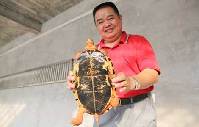For the love of tigers, she sets them free
Quan says that there were many worrying moments in the project, and one big disaster was the death of one tiger, Hope, in 2005 from pneumonia and heart failure. Quan says her team never had the chance to discover the cause of Hope's illness because he died soon after the symptoms were discovered.
Quan says Hope's death put a lot of pressure on her because some people blamed her and said it proved the rewilding project would ultimately fail. For a moment, she says, she began to think she had been wrong.
"The worst is that I felt maybe the tigers didn't have hope because they are genetically so inbred."
But she pressed on and proved her critics wrong.
"I had no choice. I kept going. I had to."
In 2007, Huloo, the first second-generation tiger, was born, and was followed by another 10 cubs over the years.
Just as the project was enjoying great success, Quan encountered a big challenge. Her marriage was falling apart. Her husband, who worked with her to rewild the tigers and headed the charity, cut her off from it.
Quan says that she no longer has access to the tigers, and has become anxious about them. But she has taken comfort from the fact that the Chinese government has told her it will translocate all 14 tigers from South Africa to Meihuashan some time next year.
The tigers are now capable of living in the wild, so will be able to cope with Meihuashan's environment, she says. The Chinese government has chosen three potential habitats for them, in Jiangxi, Hunan and Hubei, where the tigers are expected to live permanently and then breed in the wild by themselves.
Meanwhile, Quan has established a new charity, called China Tiger Revival, which she says she will help fund with the settlement money from her divorce.
She says China Tiger Revival will not be rewilding South China tigers, as this step is already completed. Instead, it will focus on sharing the knowledge of tiger rewilding with other organizations so they can use the method to help save other animals.
For the video: Reintroducing tigers to the wild


















